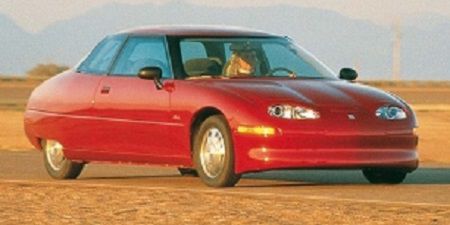Across America, evidence that the EV1 was once the most forward-thinking car on sale is elusive; none are owned by private drivers, and even the few EV1s displayed in museums and institutes cannot function.

General Motors EV1 1996
- YEAR REVEALED 1996
- PLACE OF ORIGIN Lansing, Michigan
- HISTORICAL STATUS production car
- ENGINE electric motor
- MAXIMUM POWER 137bhp equivalent
- LAYOUT front-mounted engine driving the front wheels
- BODYWORK two-door, two-seater coupé
- TOP SPEED 80mph (129kph)
- NUMBER BUILT 1,117
In 1996, the EV1 was the boldest electric car venture yet undertaken by a US carmaker, and the first mainstream car designed to run exclusively on batteries. At first, these were traditional lead-acid units offering a 75-mile (121-km) range at most, but a 1999 second-generation EV1 switched to nickel-metal hydride batteries, boosting range to 150 miles (241km).
Regenerative braking perked up charge on the move. General Motors built the EV1 to exploit the California Air Resources Board’s 1990 “Zero-Emission Vehicle” (ZEV) mandate, which decreed that by 2003, 10 percent of all cars sold in the state must be emissions-free to alleviate chronic pollution.
They were so tailor-made for sunshine states-California, Arizona, and Georgia-that cold weather meant EV1s could suffer elsewhere. Rather than sell the cars direct, EV1s were leased to selected customers, who paid up to $549 a month.
Users were hugely enthusiastic about the plastic-bodied two-seater, which was smooth and quiet. It’s also the most aerodynamic car ever marketed, with a drag coefficient of 0.19. However, by 2004, and with all leases expired, General Motors destroyed the bulk of EV1s; it claimed the car was hugely loss-making, risked liabilities, and amended environmental laws made it redundant.